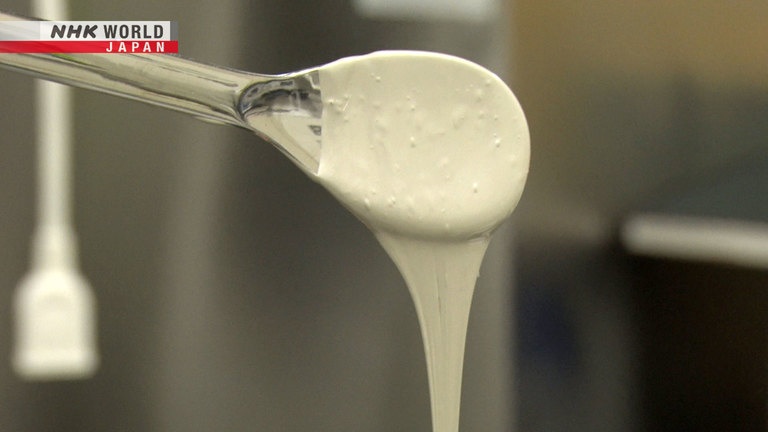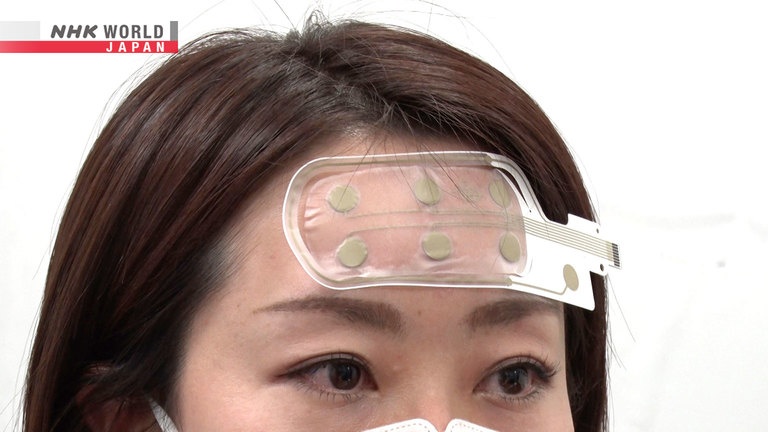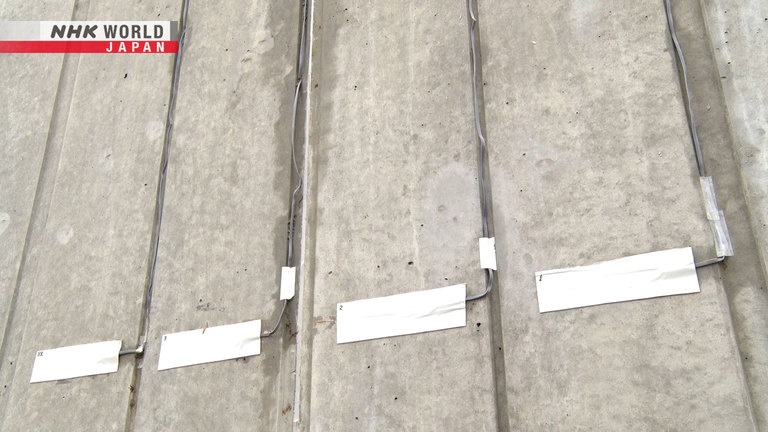The New Future with Nanomaterials
Japan's mastery of nanomaterials culminated in 2016 with the invention of the electroencephalograph (EEG) patch, a revolutionary new medical device made possible with the technology. EEGs once required major equipment, time and costs, but the EEG patch makes a quick brainwave scan possible just by placing it on the patient's forehead. It can even be used in other fields, such as scanning for building infrastructure issues. In this episode, we examine the nanomaterial that is poised to bring about a new future.



Transcript
Hello. My name is Nao.
I detect alpha waves.
Entering relaxation mode.
You might expect this episode to introduce a robot created from cutting-edge nanotechnology.
Entering super relaxation mode.
But actually, today's topic is the brainwaves the robot scans to judge relaxation levels.
The once laborious process of scanning brainwaves can now be achieved as easily as applying a small device to the forehead.
It's all thanks to the electroencephalograph patch.
The invention was the creation of Osaka University Professor Tsuyoshi Sekitani.
My lab designs electronics embedded in thin,
soft sheets.
We're researching the use of
components like electrodes and transistors in pliable film and elastic rubber.
This technology came together in the world's first
thin and soft electroencephalograph.
The key to performing electroencephalograms, or "EEGs," is the world's thinnest, lightest, and most flexible electrode sheet.
An object elastic like rubber but conductive
like metal hadn't existed until now.
It was made possible by the very detailed
material technology that Japan excels at.
The components of the sheet are nanomaterial, the name for materials with particles of 100 nanometers or smaller.
At 100,000 times smaller than the thickness of a human hair, it's a microcosmic world that defies imagination.
Nanomaterials can be put to use in ways that would be impossible for conventional components.
The electrode sheet's advanced technology could be used in everything from medical treatment to building infrastructure, creating a realm of limitless possibilities.
My lab seeks to address issues unavoidable to
society before they arise.
In this episode, we examine the latest uses for Japan's cutting-edge nanomaterial technology.
Unprecedented research with the potential to change the future of medical treatment is underway at the Osaka University Graduate School of Medicine.
Hello. Please have a seat.
We'll apply this sheet to your forehead
in order to measure your brainwaves.
This is the EEG sheet.
- It's very small.
- Isn't it?
I expected it to be bigger.
I'll apply it now.
To measure a patient's brainwaves, first a sheet is applied to their forehead.
Then, it's as simple as attaching a measuring device.
We're ready to begin.
Very simple, isn't it?
That's right.
After just a few minutes, the brainwaves are rendered.
The readings are coming through.
The process, including the doctor's instructions, takes just eight minutes seated.
We're all done. Thank you.
Thanks to this new technology, EEGs can be performed with an unobtrusive patch.
Compared to previous methods, the technique is nothing short of revolutionary.
Brainwave scans are a method of measuring the electrical activity of the surface layer of the brain.
But the signals transmitted through the scalp are minute when compared with the circulatory system or muscles.
Until now, their measurement had been an arduous process.
The breakthrough that changed this was the invention of the ultra-thin electrode sheet.
In 2019, Professor Sekitani succeeded in developing the world's thinnest and lightest electronic circuit.
Featured in journals such as the British Nature Electronics, his invention astounded the world.
It's made from electrodes to measure the brainwaves
and an adhesive to apply to the forehead.
But its thickness is just 10 μm,
the same as plastic wrap.
To gauge brainwaves most effectively, the EEG was designed with the elasticity to stretch along with skin.
The skin on our bodies stretches by almost 70%.
In order to measure a signal
from outside the skin, materials need to be soft and
thin enough to flex with it.
That's why we insisted on such thin
and flexible materials.
Brainwaves are known for being especially difficult to measure.
Previously, EEGs had involved the application of 20 electrodes all around the patient's head.
It used the same kind of large equipment as for MRIs, and required a lengthy measurement period.
Taking a brainwave scan had been very challenging.
The precise placement of the electrodes and such
meant that very few doctors were specialized in it.
But with this elastic patch that adheres
to the forehead, it's much easier.
The simplification of brainwave measurement could bring fundamental changes to medical treatment.
This demonstrative experiment shows its possibilities for early detection of dementia, raising hopes for use in Japan's aging population.
Some patients suffer from dementia for which
medicine hasn't yet been developed.
Taking early action lets us make preparations
and relieve their symptoms.
This accessible, affordable, non-invasive
testing method holds great appeal.
In addition to brainwaves, the sheet can monitor other vital signs, with the potential for use in maternity health.
It could be used to observe
the movements of uterine muscles, and indirectly perform an ECG on the fetus.
This could herald a major medical advance.
I hope it can visualize what we've been
unable to see before.
Sekitani's base of operations is the Institute of Scientific and Industrial Research at Osaka University.
At this lab, the professor gives us a demonstration of assembly of the electrode sheet.
The first step in creating the device is inserting the thin sheet of rubber that houses it into a small printer.
It looks just like the printers people use to make
their own holiday greeting cards.
This is actually a cutting-edge technology
known as printed electronics.
Then a bright metallic paste is applied to the surface of the rubber.
It smoothly flows into the pattern of the circuits.
It's transferred like this...
Once heat is applied and the material dries, it's removed from the mold.
In this completed electrode sheet, rubber and electrodes expand as one.
This unique paste was key to the sheet's completion.
It's a mass of Sekitani's creativity given form.
Just making this paste is extremely difficult.
It needs to be conductive, but elastic like rubber.
That requires the technology to mix very fine
metallic particles uniformly throughout the rubber paste.
Viewing the electrodes under an electron microscope reveals an interesting sight… Within the white rubber, black metallic particles appear as flakes.
These are particles of silver.
The special process to uniformly imbed them in the rubber was realized through three long years of research.
The result was the first nanomaterial of its kind.
Combining nano components results in a material
that still conducts electricity even when stretched out.
Even when extended, the internal particles maintain the circuit, allowing electricity to flow uninterrupted.
As elastic as conventional rubber, and yet with an unbroken flow… The device harnessed the possibilities of nanomaterials to intrigue people around the world.
Commercializing this experimental technology requires close cooperation from various business partners.
Sekitani pays a visit to an electronics manufacturer located in Ibaraki prefecture.
In order to increase production of the sheets and widen distribution, he's aggressively sought out new collaborators.
His role doesn't end at overseeing manufacturing as a whole.
He pays attention to the smallest details, including the resins and adhesives used.
The components are thermoplastic,
so they integrate just by applying heat.
They're completely different from flexible resins.
Stepping out of his lab to negotiate with specialists in a wide range of industries is yet another of Sekitani's roles.
We examine many different aspects so that the EEG sheet
can be used by many healthcare professionals.
Not just accuracy in construction,
but also ease of use and affordability are key.
I reaffirmed my belief that discussion
with those in the field is important.
To Sekitani, completion of the sheet is not the goal, but the starting point in making medical instruments accessible to the world.
His next destination was a Tokyo-based company providing medical and IT-related services.
This company was in fact founded by Sekitani himself, in pursuit of commercializing patch EEG technology.
He named it PGV: Perpetual Gratitude & Voyage.
Through extensive trial and error, they've worked to make measuring instruments as safe, compact, and easy to use as possible.
Their latest creation is no larger than a business card.
At 42 grams, it's lighter than an egg.
We planned to manufacture the EEGs
certified as medical equipment.
That was our intent for the project.
This system not only measures data, but also analyzes it.
It holds the potential to go beyond medical treatment to realize new forms of business.
A woman is observing two videos, with positive and negative connotations.
The technology known as an "emotional AI model"is capable of reading human reactions through brainwaves rather than words.
It's used in a new survey method called "neuro-research," which puts brainwave data to use in product development and marketing.
A key aspect was that its ease of measurement
will allow a wide range of use.
It's our job to support and implement
Professor Sekitani's research.
The way he warmly watches over our work
and offers advice is just like a sun shining over us.
Sekitani almost always sports a suit.
It's because he considers himself a salesman first and foremost.
In search of new business, he visits an electronics expo held in Tokyo.
It's one of Japan's largest events of its kind, where technologies such as 5G, electric vehicles, and robots line the halls.
It attracts over three hundred exhibitors and nearly thirty thousand attendees.
Sekitani delivers a keynote speech at the event.
He speaks in-depth on brainwaves and AI analysis tools.
After his presentation, businesspeople from a range of industries wait patiently in line to exchange business cards and say hello.
He gave a friendly impression,
the opposite of the "stern professor."
I could tell he excelled at development and marketing.
Our work doesn't end at research and development.
Conveying our results and information to society
informs of new obstacles and potential uses.
Professor Sekitani makes a point of distinguishing himself from the image of a typical researcher.
His reasons for this are rooted in his childhood.
Before even I turned one, our family went to
Brazil for my father's work.
The foundation of research is failing initially, because you're attempting to do
something for the first time.
It's important to think in a very proactive,
optimistic way, and that's an attitude I feel is often seen in Brazil.
Growing accustomed to that mindset so early in life
was probably very fortunate to my future as a researcher.
At age 15, a new stage in Sekitani's life took flight.
The successful launch of Space Shuttle Endeavor, carrying Japanese astronaut Mamoru Mohri into space, was broadcast live.
Seeing something so massive launched into space
impressed upon me the might of scientific technology.
To encounter the formerly unknown,
and to seek new technology and experience, I was awed by the ambition of the human race.
The target of Sekitani's admiration was more than the astronauts themselves.
It was the materials used to construct the shuttle that carried them on their voyage.
He attained his doctorate at the University of Tokyo School of Engineering, where he studied measurement of particles that react to extreme environments such as low temperatures and strong magnetic fields.
As with this EEG, my efforts were in the hopes
of contributing to the field of medicine.
Man still has many afflictions
that can't be accurately measured.
Thinking that our instruments
measuring the most extreme particles could be used in medicine started
my research from a different place.
Sekitani's aspirations exceed well beyond the field of medicine: He seeks to act for the good of society.
The electrode sheet he developed with this goal is now being put to use in an entirely different area.
In Osaka's town of Toyono, he's working with local engineers to perform infrastructure checks on the buildings.
He's currently examining a tunnel that was constructed 36 years ago.
It's right here. You can see
where they had to make some repairs.
There's some run-off and cracking.
Rust run-off has seeped from the metal framework inside the concrete, and new cracks have emerged around previous repairs.
Since it progresses internally over a long span of time, degradation of building structures is difficult to read in advance.
Repairs and inspections are labor-intensive, requiring considerable expenses that are sometimes delayed out of necessity.
Recently, this neglect has posed a very real danger.
In 2012, the ceiling of a highway tunnel in Yamanashi prefecture came crashing down, claiming the lives of the passengers in several vehicles beneath.
Then in 2021, a water pipe in Wakayama prefecture partially collapsed.
The incident interrupted the water supply to countless residents.
The issue of infrastructure maintenance is of immediate importance to the entire nation.
For municipalities facing limited budgets and manpower, finding a sustainable answer for the maintenance requires seeking out new solutions.
It's fortunate this section is a railing.
If it were the lower part that cars pass over, it could receive constant wear
that would compromise the structure.
Attention needs to be paid to keep this
from progressing in areas not outwardly visible.
Concealed areas need to be analyzed affordably.
It's an ideal test of the application of Sekitani's electrode sheet.
We've succeeded in making thin sensor sheets
that can be applied to a variety of surfaces.
They could be used on structures like these,
or the concrete that supports our lives in society.
As thin and pliable sheets, I hope the sensors
can be made useful on all sorts of structures.
This "infrastructure sensor sheet" adapts the electrode sheet for a new use.
It's already in the process of testing in several municipalities.
A member of Sekitani's laboratory is checking the structural integrity of reinforced concrete.
He detects the points where the frame converges and marks them.
The palm-sized sheet is capable of reading the slight change in potential shown by structural corrosion.
It used to be that for testing
of corrosion or half-cell potential, people had to go out and apply electrodes directly.
But the sheet-based sensors we're developing
are extremely durable for extended periods of time.
Attaching the sheet allows the data to be transmitted wirelessly.
The system then lets them monitor steel corrosion over long periods of time, ascertaining advanced signs of problems like concrete cracking.
The sensor can realize a means of management that's both efficient and sustainable.
Progress has started towards this goal through a shared effort with Toyono known as the Next-Generation Public Infrastructure Project.
The project center occupies 25% of the residential district where it's located, and is used as a testing site for infrastructure models.
We're going to apply all kinds of sensors
we're working on to that open area there.
- We should keep at it.
- Absolutely.
An array of structures are scheduled to be built in the facility.
Among them, new technologies such as solar generators, drones, and 3D data measurement will be put to the test.
I'd like to provide technology that can easily be put
to use by local governments in many structures.
Using a testing site like this
to accumulate data brings us closer to that.
When it rains like today, the soil gets looser
and it affects the concrete in some ways.
That's among the data we're collecting.
It's all very significant.
Sekitani strives to bring the nanomaterial he developed to society by reaching out to as many different industries as possible.
His ultimate goal is to create an electronic device so tiny that it could travel within human veins.
With that, currently impossible treatment methods might become a reality, where medical care could be achieved without the need for surgery.
"Perpetual gratitude."
While showing our admiration for the brain, the symbol of human wisdom,
and for technological development,
we make use of that technology to realize
a "perpetual voyage" into a greater future.
I hope that the technology to accurately
measure the brain can contribute to that.
The voyage of a boy once enthralled by the potential of deep space is now one man's perpetual odyssey.